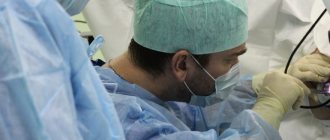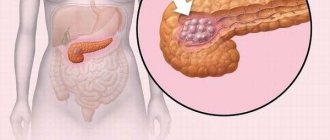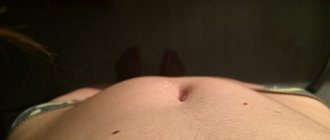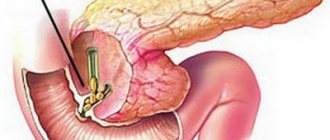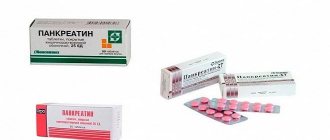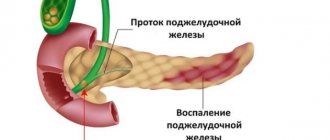Surgical intervention for acute pancreatitis can be emergency or urgent; the procedure is performed in the first hours of an attack, as well as in the first days of manifestation of the disease in the patient. The indication in this case is peritonitis of the enzymatic or acute type, which is caused by blockage of the duodenal papilla. A delayed type of surgical intervention is carried out during the phase of rejection and melting of necrotic areas and retroperitoneal tissue. As a rule, this occurs on the tenth day after the onset of an acute attack in the patient.
Planned operations for pancreatitis are carried out during the complete elimination of inflammatory processes in the diseased organ. The goal in this case is to prevent the recurrent course of the disease. Any measures are taken only after a thorough diagnosis, and in addition, a comprehensive examination of the patient. We will find out in what situations surgical intervention is required, and also find out what complications and consequences may arise during the recovery period.
When is surgery performed for pancreatitis?
The need for surgical treatment is determined by diseases of the pancreas when severe damage to the tissues of the organ is observed. As a rule, surgery is performed in cases where alternative options only lead to failure, or when the patient is in an extremely serious and dangerous condition.
It must be taken into account that any intervention in an organ of the human body is fraught with all sorts of negative consequences. The mechanical path never guarantees the patient’s recovery, but, on the contrary, there is always a risk of extensive deterioration of the overall health picture. Symptoms and treatment of pancreatitis in adults are often interrelated.
In addition, only a highly qualified doctor with a narrow specialization can perform the operation, and not all medical institutions can boast of such specialists. So, surgical intervention on the pancreas in the presence of pancreatitis is performed in the following situations:
- The patient's condition is marked by the acute phase of a destructive disease. With such a picture, decomposition of the tissues of the diseased organ of a necrotic type is observed, and the addition of purulent processes is not excluded, which serves as a direct threat to the life of the patient.
- The presence of pancreatitis in acute or chronic form, which has progressed to the stage of pancreatic necrosis, that is, necrotic dissection of living tissue.
- The chronic nature of pancreatitis, which is marked by frequent and acute attacks with a short time of remission.
All of these pathologies, if left untreated, can lead to fatal consequences. Moreover, any methods of conservative treatment will not give the desired result, which is a direct indication for surgery.
When is surgery performed for chronic pancreatitis?
The development of pancreatitis and the transition of the disease to a chronic course is accompanied by a violation of the morphological structure of the pancreas tissue. Most often, cysts, stones, stenosis of the main duct of the pancreas or biliary tract are formed, a significant increase in the size of the head of the organ due to inflammation (indurative, or “capitate” pancreatitis), when compression of adjacent neighboring organs occurs:
- duodenum,
- antrum of the stomach,
- biliary tract,
- portal vein and its tributaries.
In such cases, the patient is hospitalized in the surgical department if drug treatment was ineffective at the previous stages, and the patient’s condition has become significantly worse, or life-threatening complications have arisen. Deterioration of the condition manifests itself:
- increased pain,
- the appearance of signs of peritoneal irritation,
- increasing intoxication,
- an increase in blood and urine amylase.
Surgical treatment is carried out according to strict indications, since any impact on the pancreas can lead to aggravation of the situation.
The chronic course of pancreatitis is manifested by almost constantly present symptoms of the disease due to inflammation and fibrosis of organ tissue.
Surgical intervention is often used in the early stages of the disease (days 1–5) in the following situations:
- if there are signs of peritonitis,
- with severe pain syndrome,
- with obstructive jaundice,
- in the presence of stones in the gallbladder and ducts.
In rare cases, emergency operations are performed when CP occurs:
- acute bleeding into the cavity of the pseudocyst or the lumen of the gastrointestinal tract,
- cyst rupture.
In most cases, surgical treatment for CP is carried out routinely after a thorough diagnosis.
There are some contraindications to radical treatments on the pancreas:
- progressive drop in blood pressure,
- anuria (complete lack of urine output),
- high hyperglycemia,
- inability to restore circulating blood volume.
Indications for surgery
Surgery for chronic pancreatitis is indicated in the following cases:
- refractoriness (stability) of a pain symptom in the abdomen to the effects of medications,
- indurative pancreatitis (when, as a result of a long-term inflammatory process, connective tissue grows and scars appear, the mass and size of the pancreas significantly increases, but its functions sharply decrease),
- multiple narrowings (strictures) of the main pancreatic duct,
- stenosis of intrapancreatic biliary tract,
- compression of the main vessels (portal or superior mesenteric vein),
- long-term pseudocysts,
- inductive changes in the tissues of the pancreas, raising suspicion of a malignant neoplasm (the risk of cancer in the presence of CP increases 5 times),
- severe stenosis of the duodenum.
Efficiency of surgical treatment methods
The result of surgical intervention is the elimination of pain, the liberation of the body from intoxication by products of inflammation and decay, and the restoration of normal functioning of the pancreas. Surgical treatment is an effective prevention of complications of pancreatitis: fistulas, cysts, ascites, pleurisy, various purulent lesions.
The effectiveness of surgical treatment of CP is associated with the specific pathology of the pancreas and two main difficulties, and is directly dependent on how they can be overcome:
- Pathological changes in pancreatic tissue are severe, widespread and irreversible. A successful operation must be subsequently accompanied by long-term, sometimes lifelong, replacement therapy and adherence to a prescribed strict diet. This recommendation is an important condition for successful treatment, without which the effectiveness of surgical treatment will be reduced to zero.
- In most cases, CP has an alcoholic etiology. If alcohol intake continues after a series of expensive, complex surgical interventions, the effectiveness of surgical treatment will be short-lived.
The main difficulties in performing surgical treatment
Surgery against the background of pancreatitis is always a complex and difficult to predict procedure, which is based on a number of aspects that are related to the anatomy of the internal organs of mixed secretion.
The tissues of the internal organs are highly fragile, so the slightest manipulation can cause severe bleeding. A similar complication cannot be ruled out during the patient’s recovery.
In addition, vital organs are located in close proximity to the gland, and minor damage to them can lead to serious disruptions in the human body, as well as irreversible consequences. The secretion, along with enzymes produced directly in the organ, affects it from the inside, which leads to tissue dissection, significantly complicating the operation.
What it is
Surgery on the pancreas for pancreatitis, depending on the characteristics of a particular case, can be of a different nature and can be quite complex.
The operation is carried out after clarification of certain factors, specifically the presence of demarcation of damaged tissues from healthy ones, the extent of the prevalence of the purulent-necrotic process in the pancreas, the degree of inflammation and the presence of concomitant gastrointestinal diseases. The surgical method is carried out using laparoscopy, a translaparotomic method of examining the pancreas and abdominal cavity.
During laparoscopy of pancreatic enzymatic peritonitis, laparoscopic drainage of the abdominal cavity is prescribed, and then peritoneal dialysis and drug infusion. The operation is performed under the control of a laparoscope. Microirrigators are applied to the omental foramen and the left subdiaphragmatic space, and a large-diameter drainage is inserted into the small pelvis through a small puncture of the abdominal wall in the left iliac zone.
Dialysis solutions contain antibiotics, antiproteases, cytostatics, antiseptics, and glucose solutions. The method is effective only for the first three days after the onset of acute peritonitis is detected. The method is not performed for fatty pancreatic necrosis, as well as for biliary pancreatitis. Decompression of the biliary tract in pancreatogenic peritonitis is performed by laparoscopic drainage of the abdominal cavity, supplemented by the application of a cholecystoma.
In the case when an edematous form of pancreatitis is detected during laparotomy, the tissue surrounding the pancreas is infiltrated with a composition of novocaine and an antibiotic, cytostatics, and protease inhibitors. For further infusions of drugs, a microirrigator is inserted into the root of the mesentery of the transverse colon. Afterwards, the omental orifice is drained and a cholecystoma is applied. To prevent the entry of enzymes and the spread of toxic breakdown products into the retroperitoneal tissue, the body and tail of the pancreas are isolated from the parapancreatic tissue. If necrosis progresses after surgery, relaparatomy is performed, which is inappropriate due to the large load on the weakened body.
One of the types of disease that requires surgical treatment is calculous pancreatitis, a characteristic feature of which is the presence of stones in the pancreas. When the stone is localized in the ducts, only the wall of the duct is dissected. If there are several stones, then the dissection is carried out along the entire gland. In some cases, complete resection of the organ damaged by stones is indicated.
When a cyst is found in the pancreas, it is removed along with part of the gland. Sometimes it is necessary to completely remove the organ. When diagnosing cancer, radical treatment methods are used.
The most serious intervention performed for acute pancreatitis is pancreatectomy. The operation is performed with complete necrosis of the pancreas; during surgery, part of the pancreas and 12 rings of the intestine are left.
This operation does not guarantee recovery and improved quality of life, it is traumatic, and has a high percentage of deaths. This method can be replaced by kirodistortion, which is carried out for hemorrhagic pancryonecrosis. During the operation, tissue is exposed to ultra-low temperatures. Healthy connective tissue is formed at the site of exposure. If concomitant pathologies associated with the biliary tract are detected, the use of this method is not allowed, since there is a risk of damage to the gallbladder, 12 rings of the intestine and stomach.
The endoscopic method is used for local complications of chronic pancreatitis, when there is a pseudocyst, narrowing of the main duct of the gland, the presence of stones in the ducts of the pancreas or gall bladder. They can lead to pancreatic hypertension and require endoscopic interventional techniques.
The most popular procedure is sphincterotomy, which is accompanied by endoprosthetics of the main pancreatic duct, and if a stone is present, its removal or lithotripsy, drainage of the cyst. The endoprosthesis must be replaced every 3 months; in such cases, anti-inflammatory therapy is recommended for a year.
The prognosis for the treatment of destructive types of pancreatitis is unfavorable, since there is a high percentage of deaths.
Symptoms and treatment of pancreatitis in adults
Acute pancreatitis is characterized by the following symptoms:
- Severe abdominal pain localized in both the right and left hypochondrium.
- General malaise.
- Increased body temperature.
- Nausea and vomiting, but no relief after emptying the stomach.
- Constipation or diarrhea.
- Moderate shortness of breath.
- Hiccups.
- Bloating and other unpleasant sensations in the stomach.
- Changes in skin color - the appearance of bluish spots, yellowing or redness of the face.
The patient is placed in a ward where intensive care is provided. In severe cases, surgery is required.
Prescribed drug therapy:
- antibiotics;
- anti-inflammatory drugs;
- enzymes;
- hormones;
- calcium;
- choleretic drugs;
- enveloping herbal preparations.
Pancreatic surgery: patient reviews
Having studied cases of surgical treatment, we can say that the responses are quite positive. We are mainly talking about malignant neoplasms in the pancreas. Relatives and the patients themselves say that they managed to overcome the disease, despite their fears.
Thus, surgical intervention, thanks to the help of qualified specialists, is a kind of lifeline for patients.
There are also reviews from people about pancreatic necrosis. As is known, this disease is an advanced case of acute pancreatitis. A large number of thanks to surgeons from people who helped them survive can be seen on the Internet.
It follows from this that, despite the fact that pancreatic surgery is considered one of the most complex surgical treatments, it helps the patient to get out and continue to work in the same spirit. Just don’t forget a number of recommendations and advice given by your doctor. And then you will feel like a healthy and complete person.
Complications after surgery
After operations for pancreatitis, the following complications are likely to occur:
- Necrotic or purulent contents may begin to accumulate in the abdominal cavity; in scientific terms, the patient is diagnosed with peritonitis.
- It happens that there is an exacerbation of concomitant diseases associated with the activity of the pancreas and the production of enzymes.
- There is a process of clogging of the main channels, which can lead to exacerbation of pancreatitis.
- The soft tissues of the diseased organ may not heal, and positive dynamics of recovery of the pancreas may not be observed.
- The most dangerous complications include multiple organ failure along with pancreatic and septic shock.
- Later negative consequences of surgery for pancreatitis include the appearance of a pseudocyst along with pancreatic fistulas, the development of diabetes mellitus and exocrine insufficiency.
How does surgery occur?
Pancreatic cancer also requires surgery. Other cases in which surgical treatment is necessary were listed above. Also, for pancreatic cysts, surgery is a mandatory procedure. Surgical treatment is performed under general anesthesia and muscle relaxants.
If there are symptoms of internal bleeding, then emergency surgery on this organ is required. In other cases, planned surgical intervention is performed.
So, surgery on the pancreas is performed as follows:
- First, the organ is opened;
- the omental bursa is freed from blood;
- superficial ruptures of the pancreas are sutured;
- hematomas are opened and bandaged;
- if an organ rupture occurs, sutures are placed on it, and at this time the pancreatic duct is sutured;
- if the main abnormalities are in the tail of the pancreas, then this part is removed along with the spleen;
- if the head of the organ is damaged, it is also removed, but with part of the duodenum;
- surgical intervention ends with drainage of the omental bursa.
Preparation for surgery
Regardless of the type of pancreatitis, be it parenchymal, biliary, alcoholic, calculous, and so on, the main event in preparation is absolute fasting, which, unfortunately, helps to worsen the disease. We will consider further what operations are performed for pancreatitis.
The absence of food in the organs of the digestive system significantly reduces the likelihood of postoperative complications. Immediately on the day of the operation, the patient cannot eat; he is given a cleansing enema, after which he is given premedication. The latter procedure involves the administration of medications to help the patient ease the transition into a state of anesthesia. Such drugs completely suppress the fear of medical procedures, helping to reduce the secretion of the gland and preventing the development of allergic reactions. For these purposes, various medications are used, ranging from tranquilizers and antihistamine injections to anticholinergics and antipsychotics.
Below are the surgical techniques for acute pancreatitis.
Types of surgery on the pancreas
Pathology of the pancreas is studied at the St. Petersburg State Medical Academy named after I.I. Mechnikov, where many invasive and medicinal techniques were developed.
Treatment has some limitations due to the fact that for any indication for surgery, the operation should not be more severe than the disease itself. This means that the optimal amount of radical impact on the pancreas is necessary, taking into account the individual characteristics of the patient in each specific case.
All types of interventions, depending on their volume and method of implementation, are classified into organ-preserving or with removal of part or all of the pancreas:
- direct - partial, subtotal or total resection of the pancreas, capsulotomy,
- indirect - drainage of the biliary tract, operations on the gastrointestinal tract, nerve trunks.
Depending on the medical history, the patient’s condition, and changes in the pancreas tissue, surgical procedures are performed using various techniques.
The extent of the operation depends on the pathology of the pancreas:
- In case of injury, the omental bursa is opened, blood, damaged tissue, and pancreatic secretions are removed. Then the tissue is sutured, the vessels are sutured and drainage is installed.
- As a result of complete rupture of the pancreas, the main duct is sutured or an anastomosis (message) is made between the jejunum and the gland. After the operation, the omental bursa is drained.
- Large stones are removed from the pancreas tissue, the duct is drained and sutured.
- If there are many stones, they are removed, the narrowings are dissected and an anastomosis is applied - a connection between the gland and the small intestine.
- If a fistula (external or internal pathological tract) is detected, it is excised with drainage removed to the outside or an artificial anastomosis is formed between the intestine and the pancreas.
- For health reasons, total removal of the pancreas is performed. This is due to the aggressive effect of pancreatic juice with the enzymes it contains, which, when released into the bloodstream, cause shock and self-digestion on neighboring organs.
- open method - with laparotomy (large incision on the anterior abdominal wall from the symphysis to the xiphoid process of the sternum),
- minimally invasive - using the laparoscopic method (several incisions 0.5–1 cm in size are made on the abdomen, through one of them a special probe with an eyepiece is inserted - a laparoscope, through other holes - manipulators are used, with the help of which the operation itself is performed).
All surgical interventions can be performed:
Laparoscopy can be done under the control of an image displayed on a screen. After such a procedure, the postoperative period, length of hospital stay and rehabilitation are sharply reduced, and the risk of complications is significantly reduced.
Minimally invasive methods
Modern progressive methods for removing pancreatic tumors include bloodless operations:
- radiosurgery - using powerful radiation through a cyber knife,
- cryosurgery - tumor freezing,
- laser surgery,
- fixed ultrasound.
Except for the cyber knife, all technologies are performed through a probe inserted into the duodenal lumen.
Newest technologies
At the National Institute of Surgery and Transplantology named after. A.A. Shalimov has developed and successfully carried out minimally invasive interventions on the ducts of the gallbladder and pancreas using X-ray endoscopic surgery. The operation lasts from 15 minutes to 1.5 hours, regardless of the severity of the process, and is practically bloodless, since high-tech instruments are used: a duodenfibroscope with side optics, which is inserted through the mouth. The thickness of the instrument for manipulation of ducts, sphincters and vessels is 1.8 mm, and its entrance section is 0.5 mm. The electric knife cuts and immediately coagulates the tissue, eliminating bleeding. A special nitenol stent with memory properties is inserted into the narrowed part of the duct, and the existing stones are removed. In case of tumor damage to the duct, the stent prolongs the patient’s life from 3 months to 3 years.
If it is impossible to carry out radical operations for various reasons, the installation of self-expanding stents is a very effective therapeutic laparoscopic method that has received the best feedback from specialists.
Intraluminal (endoluminal - carried out in the lumen of the small ducts of the pancreas and gallbladder) diagnostic and surgical interventions using echoendoscopes (endoscope with ultrasound scanner) make it possible to identify and remove malignant neoplasms in the early stages. Such interventions are well tolerated by both adults and children.
The latest NOTES technology allows for surgical treatment of gallbladder pathology, removal of pancreatic cysts and tumors through natural orifices of the body. No incision is made on the abdominal wall. Due to the high price of the equipment, not all clinics can have it. Such endoscopic equipment is available in Novosibirsk, where similar interventions are carried out for pathologies of the abdominal organs.
Operations necessary for acute pancreatitis
If acute pancreatitis develops, the patient is immediately hospitalized in a hospital where there is a surgical department; if necessary, early surgical intervention is performed. An attack is not always an absolute indication for surgical treatment of acute pancreatitis. An organ is removed if:
- tissue necrosis begins,
- the pathology is not amenable to conservative treatment, and after 2 days of active therapy the patient’s condition worsened,
- Acute pancreatitis with increasing edema has developed, and enzymatic peritonitis begins due to blockage of the greater nipple of the duodenum, later purulent - an emergency (in the first hours of the attack) or urgent (in the first days of the exacerbation) operation is performed.
Delayed surgical intervention (10-14 days from the onset of the attack) is carried out during the melting and rejection of necrotic areas of the pancreas.
If surgical intervention is not performed in a timely manner with increasing pancreatic necrosis, death occurs in 100% of cases.
The following types of surgical treatment are used:
- distal resection of the pancreas - on the body and tail of the organ,
- corpocaudal resection - removal of a cancerous tumor on the body and tail,
- necrectomy - removal of dead areas of the gland,
- drainage of places with suppuration - abscesses, cysts, other formations,
- complete pancreatectomy - removal of the entire pancreas,
- resection of the head of the gland.
Surgery for pancreatic pseudocysts
A complication of acute pancreatitis, for which surgical treatment is applied, is a false cyst - a cavity filled with pancreatic juice, necrotic masses, possibly blood. Its walls are represented by dense connective tissue, the inner surface is not lined with epithelium, which is why the cyst is called a pseudocyst.
A false cyst reaches a maximum of 40 cm; it can grow into a large vessel and cause bleeding with a fatal outcome. If the size of the formation is less than 5 cm, there is not a single clinical symptom. It is an incidental finding on ultrasound, CT, MRI performed for another reason.
If complaints occur (dull pain, nausea, heaviness in the stomach), the pseudocyst is removed along with part of the pancreas. It is possible to carry out enucleation (husking) of the cyst, its internal or external drainage under ultrasound control.
Resection of part of the pancreas or complete removal
Operations on the pancreatic parenchyma can be performed in 2 ways:
- resection of part of an organ,
- pancreatectomy - complete removal of the gland.
If a pathology is detected (tumor, cyst, stone, necrotic area), the head, body or tail of the gland - any anatomical affected part of the pancreas - is operated on.
The most difficult and highly traumatic operation with a high risk of death and complications is pancreaticoduodenectomy. This technique is used for cancer of the head, in addition to which adjacent organs are removed:
- duodenum,
- gallbladder,
- part of the stomach.
A more gentle type of operation is Frey resection: developed by the author for use in cases of pronounced changes in the tissues of the head and obstruction of the common pancreatic duct in order to restore it.
Surgical intervention consists of removing the head and dissecting the main duct lengthwise and suturing it to the duodenal loop. Thus, a wide anastomosis is created between them, and pancreatic juice freely enters the lumen of the small intestine.
Indications for complete removal of the pancreas (pancreatectomy):
- total pancreatic necrosis,
- multiple cysts throughout the gland,
- extensive malignant lesion,
- severe injuries of the pancreas with deep damage.
Surgeries for chronic pancreatitis
In patients with existing CP, 4 types of surgical interventions are performed depending on the organs that are involved in the operation and its scale.
Indirect methods:
- on the stomach (Billroth I resection of 2/3 of the stomach in the presence of a gastric ulcer penetrating into the head of the pancreas, Billroth II gastric resection with penetration of a duodenal ulcer into the head of the pancreas in combination with selective proximal vagotomy),
- on the bile ducts (for cholelithiasis or calculous cholecystitis - cholecystectomy, formation of bypass bile ducts, papillosphincteroplasty and other options),
- on the nervous system (vagotomy - dissection of the n. vagus - vagus nerve, splanchectomy - excision of the celiac nerve, which is a branch of the sympathetic trunk, forms the solar plexus and transmits pain impulses from the abdominal organs, including the pancreas, to the central nervous system, the effectiveness of the method in regarding pain symptoms is 80%), operations are performed endoscopically.
Direct methods - eliminate the cause of the delay in pancreatic secretion in order to restore its flow into the duodenal lumen (sphincterotomy, excision of stones from the pancreas).
Methods for unloading pancreatic ducts (virsunguduodenostomy, -gastrostomy, -jejunostomy and other methods of creating stomas with the cavity of the pancreatic duct).
Pancreatectomy (left-sided, total, right-sided duodenopancreatectomy).
Types of surgical interventions for pancreatitis
There are the following types of operations for pancreatitis:
- Procedure for distal organ resection. During the treatment process, the surgeon removes the tail, as well as the body of the pancreas. The volume of excision is determined by the degree of damage. Such manipulation is considered appropriate in cases where the lesion does not affect the entire organ. Diet for pancreatitis after surgery is extremely important.
- Subtotal resection means removal of the tail, most of the head of the pancreas and its body. In this case, only some segments adjacent to the duodenum are preserved. This procedure is performed exclusively for the total type of lesion.
- Necrosequestrectomy is carried out under the control of ultrasound examination and fluoroscopy. At the same time, fluid in the organ is detected by draining it through special tubes. After this, large-caliber drains are introduced in order to flush the cavity and carry out vacuum extraction. As part of the final stage of treatment, large drainages are replaced with smaller ones, which facilitates the gradual healing of the postoperative wound while maintaining the outflow of fluid. Indications for pancreatitis surgery must be strictly observed.
Among the most common complications are purulent abscesses. They can be recognized by the following symptoms:
- Presence of feverish conditions.
- Hyperglycemia with a shift in the leukocyte formula to the left.
- The affected area is filled with pus during an ultrasound examination.
Pancreatectomy
Partial removal of the gland (resection) is used for lesions by malignant tumors or mechanical damage.
It is needed much less often if the patient has chronic pancreatitis.
Considering the anatomical structure of the pancreas, it is possible to remove either the head or the distal section, that is, the body and tail.
Removal of the head of the pancreas is called pancreaticoduodenectomy.
After removing the affected organ and surrounding tissues, the stage of restoring the outflow of bile begins. Doctors reassemble the removed part of the digestive tract, where several anastomoses are created at once.
In some situations, the pancreatic duct is directed not into the intestines, but into the gastric cavity.
Distal resection is indicated for tumors of the body and tail of the gland. But practice shows that if the tumor is localized in a similar area, then it is almost always inoperable, since it has already partially penetrated the intestinal vessels.
For this reason, surgery is performed when the tumor is benign. During distal resection, the spleen is also removed.
It is impossible to predict the course of such an operation. There are well-known cases of examination already during surgery, where it was established that the tumor had spread too deeply. Then the doctors came to the conclusion that they needed to remove the entire organ.
Maybe
Rehabilitation of patients and care for them in hospital
After surgery for pancreatitis, the patient is sent to the intensive care unit. At first he is kept in intensive care, where he receives proper care and his vital signs are monitored.
The patient's poor health in the first twenty-four hours makes it very difficult to establish postoperative complications. It is mandatory to monitor urine, blood pressure, as well as hematocrit and glucose in the body. Necessary monitoring methods include chest x-ray and cardiac electrocardiogram.
On the second day, provided that the patient’s condition is relatively satisfactory, the patient is transferred to the surgical department, where he is provided with the required care along with proper nutrition and complex therapy. Food after pancreatitis surgery is carefully selected. The subsequent treatment regimen directly depends on the severity, and also on the presence or absence of negative consequences of the surgery.
Surgeons note that the patient must be under the supervision of medical personnel for one and a half to two months after surgery. This time is usually enough for the digestive system to adapt to the changes and return to its normal functioning.
As recommendations for rehabilitation, patients after discharge are advised to strictly observe complete rest, as well as bed rest; in addition, such patients need an afternoon nap and diet. The atmosphere in the home and family plays an important role. Doctors note that loved ones and relatives are obliged to support the patient. Such measures will enable the patient to be confident in the successful outcome of subsequent therapy.
Two weeks after discharge from the hospital department, the patient is allowed to go outside, taking short walks at a leisurely pace. It should be emphasized that during the recovery period, patients are strictly prohibited from overwork. The consequences of pancreatitis surgery are presented below.
Surgery for chronic pancreatitis: indications for operations and types of operations
Surgical treatment of chronic pancreatitis is indicated when conservative therapy carried out by a gastroenterologist is ineffective. According to statistics, 40% of patients with chronic pancreatitis (CP) become patients in the surgical department of a hospital due to refractoriness to therapeutic treatment and developing complications. Surgical methods stabilize the pathological process and slow down the progression of pancreatitis.
Postoperative therapy
As such, the treatment algorithm after surgery against the background of pancreatitis is determined by certain factors. In order to prescribe therapy, the doctor carefully studies the patient’s medical history along with the final outcome of the intervention, the degree of gland restoration, the results of laboratory tests and instrumental diagnostics.
If there is insufficient insulin production by the pancreas, additional insulin treatment may be prescribed. The synthetic hormone helps restore and normalize glucose levels in the human body.
It is recommended to take medications that help produce the optimal amount of enzymes, or that already contain them. Such drugs improve the functionality of the digestive organs. If these medications are not included in the treatment regimen, the patient may develop symptoms such as increased gas formation along with bloating, diarrhea and heartburn.
What else does surgical treatment of the pancreas involve?
Forecast
The prognosis after surgery depends on many factors. The success of the prognosis is influenced by the reason for choosing surgery as a method of treatment, the extent of organ damage and the volume of surgical intervention, the general condition of the patient, the presence of concomitant pathology in the postoperative period, the quality of postoperative and clinical measures, compliance with the doctor’s instructions, including diet.
Any violations of medical recommendations, excessive physical activity, or emotional stress can cause an exacerbation of the disease. With alcoholic pancreatitis, with continued use of alcoholic beverages, life expectancy is sharply reduced.
The quality of life after pancreatic surgery largely depends on the patient. If the doctor's instructions are followed and the surgical intervention is performed correctly, most patients experience an increase in quality of life.
Diet
In addition, patients are additionally recommended measures in the form of dietary nutrition, therapeutic exercises and physiotherapy. A balanced type of diet is the dominant method within the recovery period. Following a diet after organ resection involves fasting for two days, and on the third day, gentle food is allowed. In this case, it is permissible to eat the following foods:
- Tea without sugar with crackers and pureed soup.
- Porridge with milk with rice or buckwheat. During preparation, milk must be diluted with water.
- Steamed omelette, with only whites.
- Yesterday's dried bread.
- Up to fifteen grams of butter per day.
- Low-fat cottage cheese.
Before going to bed, patients are recommended to drink one glass of low-fat kefir, which can sometimes be replaced with a glass of warm water with honey. And only after ten days the patient is allowed to include some fish or meat products in his menu.
Nutrition after surgery for acute pancreatitis
During the postoperative period, the patient must follow special nutritional rules. After the operation, complete fasting is required for 2 days. Then you can introduce into the diet:
- tea;
- omelette;
- overcooked porridge;
- vegetarian soup;
- cottage cheese;
- crackers.
We recommend reading: What can you eat if you have acute pancreatitis?
For the first 7-8 days after surgery, meals should be fractional. Food should be taken up to 7-8 times during the day. The serving size should not exceed 300 g. Dishes should be boiled or steamed. The porridge is cooked only in water; the crackers need to be soaked in tea. Vegetable purees, puddings and jelly are useful.
From 2 weeks after surgery, the patient must adhere to the diet prescribed for pathologies of the digestive system. It is recommended for 3 months. Can be used:
- lean varieties of meat and fish, poultry;
- chicken eggs (no more than 2 pieces per day);
- cottage cheese;
- sour cream;
- rosehip decoction;
- fruit drinks;
- vegetables;
- butter or vegetable oil as an additive to dishes.
Drinking alcoholic beverages after surgery is contraindicated.
Recovery in a hospital lasts up to 2 months, during which time the digestive tract must adapt to other operating conditions, which are based on the enzymatic process.
